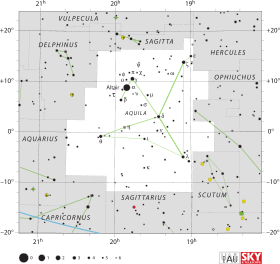W43A
W43A
| Ascension droite | 18h 47m 41,14s[1] |
|---|---|
| Déclinaison | −01° 45′ 11,4″[1] |
| Constellation | Aigle |
Localisation dans la constellation : Aigle | |
| Type spectral | OH |
|---|---|
| Variabilité | Branche asymptotique des géantes |
| Vitesse radiale | 34 km/s[2] |
|---|---|
| Distance |
2 220+380 −400 pc[2] |
| Luminosité | 12 000 L☉[3] |
|---|
Désignations
W43A ou IRAS 18450-0148 est une étoile de type tardif dotée d'une enveloppe de type OH/IR avec un jet collimaté magnétiquement (une protonébuleuse planétaire)[4]. L'étoile est aux premiers stades de sa transformation en nébuleuse planétaire, un processus qui prendra plusieurs milliers d'années[2].
Références[modifier | modifier le code]
- (en) Cet article est partiellement ou en totalité issu de l’article de Wikipédia en anglais intitulé « W43A » (voir la liste des auteurs).
- Center Spitzer Science, « VizieR Online Data Catalog: GLIMPSE Source Catalog (I + II + 3D) (IPAC 2008) », VizieR Online Data Catalog, vol. 2293, , II/293 (lire en ligne, consulté le )
- Daniel Tafoya, Hiroshi Imai, José F. Gómez et Jun-ichi Nakashima, « Shaping the Envelope of the Asymptotic Giant Branch Star W43A with a Collimated Fast Jet », The Astrophysical Journal Letters, vol. 890, no 1, , p. L14 (ISSN 2041-8205 et 2041-8213, DOI 10.3847/2041-8213/ab70b8, lire en ligne, consulté le )
- Shane B. Vickers, David J. Frew, Quentin A. Parker et Ivan S. Bojičić, « New light on Galactic post-asymptotic giant branch stars - I. First distance catalogue », Monthly Notices of the Royal Astronomical Society, vol. 447, , p. 1673–1691 (ISSN 0035-8711, DOI 10.1093/mnras/stu2383, lire en ligne, consulté le )
- Wouter H. T. Vlemmings, Philip J. Diamond et Hiroshi Imai, « A magnetically collimated jet from an evolved star », Nature, vol. 440, , p. 58–60 (ISSN 0028-0836, DOI 10.1038/nature04466, lire en ligne, consulté le )
Lectures complémentaires[modifier | modifier le code]
- Hiroshi Imai, Kumiko Obara, Philip J. Diamond et Toshihiro Omodaka, « A collimated jet of molecular gas from a star on the asymptotic giant branch », Nature, vol. 417, , p. 829–831 (ISSN 0028-0836, DOI 10.1038/nature00788, lire en ligne, consulté le )
- Hiroshi Imai, Jun-ichi Nakashima, Philip J. Diamond et Atsushi Miyazaki, « A Biconically Expanding Flow in W43A Traced by SiO Maser Emission », The Astrophysical Journal, vol. 622, , L125–L128 (ISSN 0004-637X, DOI 10.1086/429820, lire en ligne, consulté le )
- R. M. Deacon, J. M. Chapman, A. J. Green et M. N. Sevenster, « H2O Maser Observations of Candidate Post-AGB Stars and Discovery of Three High-Velocity Water Sources », The Astrophysical Journal, vol. 658, , p. 1096–1113 (ISSN 0004-637X, DOI 10.1086/511383, lire en ligne, consulté le )
- M. Szymczak et E. Gérard, « Polarimetric observations of OH masers in proto-planetary nebulae », Astronomy and Astrophysics, vol. 423, , p. 209–219 (ISSN 0004-6361, DOI 10.1051/0004-6361:20040461, lire en ligne, consulté le )
Liens externes[modifier | modifier le code]

